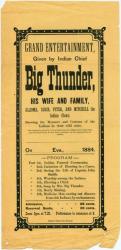Mount Desert Island began to change both culturally and geographically beginning in the 1500s as European settlements began to increase in the Northeast and the lives and livelihood of Native Americans were drastically effected. By the 1800s, white settlement on the island had forced most of the Native tribes including the Wabanaki, Passamaquoddy, and Penobscot into poverty. A substantial class gradient emerged, with natives at the bottom and wealthy, aristocratic cottage owners at the top. As the tribes struggled to get by without sacrificing their rich cultural traditions, some began to market themselves as native tour guides and Indian entertainers, performing medicine shows and traditional song and dance, selling crafts and posing for photographs in Indian dress.
These native performances and tours were wildly popular with summer visitors and Frank “Chief Big Thunder” Loring, was perhaps the most commercially successful of the lot. He was an imposing presence at 6'4" and 225 lbs, with circus-like showmanship and a keen understanding of the Vaudeville style. He was said to be a story teller of great talent and an unrepentant trickster. Along with a small group of performers including family and friends, Loring re-ennacted highly romanticized versions of 'Indian ceremonies and traditional dance' and he created traveling museum displays of tribal customs, dress and culture. Tourists were fascinated. Loring and his company were commissioned by locals to participate in town-wide events and parades to exemplify the cultural and artistic history and diversity of the area and eventually he took his act far beyond Mount Desert Island, performing across the region and on Broadway.
To learn more about this era check out the Indians and Rusticators exhibit here
or visit the Abbe Museum, located in downtown Bar Harbor.




